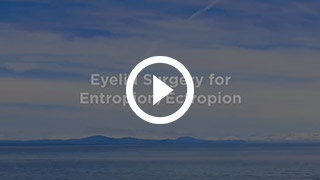Entropion Surgery
Correction of inwardly turned eyelid
Involutional entropion is the commonest form of entropion and is generally seen in patients after the 5th decade of life. It is caused by progressive weakness of the supportive structures (canthal tendons) in the lower eyelid.
Cicatricial entropion results from scarring on the conjunctival side (inside) of the lower or upper eyelid. A variety of medical conditions may lead to this form of entropion. Trauma (thermal or chemical), infection, trachoma (Chlamydia), herpes, and ocular cicatricial pemphigoid (OCP) are potential causes of cicatricial entropion.
Surgery is usually necessary to treat entropion. A temporizing measure that may correct the eyelid malposition is taping the eyelid to evert the lid margin. Surgical tape or the sticky part of a Band-Aid, placed from the lower eyelid to the cheek area, will evert the lid and relieve corneal irritation from the eyelashes. A variety of surgical techniques are utilized to treat entropion. In adults, these surgeries are done under local anesthesia as an outpatient. Correction of involutional entropion typically involves tightening the lower eyelid and turning the eyelid margin outward into a more normal position. A small incision is made in the outside corner (lateral canthus) of the eyelid. The eyelid is tightened by reattaching the tarsus (the thick, middle layer of the eyelid) to the bone of the lateral orbital rim. This surgery is referred to as a Lateral Tarsal Strip Procedure. Dissolvable sutures are preferred and the eyelid typically heals over several weeks to months.
 Watch to learn more about Entropion Surgery
Watch to learn more about Entropion Surgery
After the Procedure
A topical antibiotic is typically applied to the operated areas during the first postoperative week. Ice packs are recommended as with other eyelid surgeries for 2-3 days. It is important that the tightened eyelid not be disrupted during the first 3 weeks of healing. A protective eye shield (plastic or metal) may be useful while sleeping to minimize the risk of inadvertant wound disruption.
View Before/After Photos
